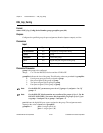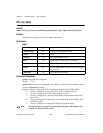
Chapter 2 Function Reference — DIG_Grp_Mode
©
National Instruments Corporation 2-167 NI-DAQ FRM for PC Compatibles
edge indicates whether the group is to be configured for leading-edge or trailing-edge pulsed
signals. edge is valid only if protocol = 1 or 2.
0: Group is configured for leading-edge pulsed handshake signals.
1: Group is configured for trailing-edge pulsed handshake signals. This setting does
not support variable ACK pulse width (protocol = 2).
reqPol indicates whether the group request signal is to be active high or active low. reqPol
is ignored if protocol = 4. protocol 4 always uses an active low request signal..
0: Group is configured for active high (non-inverted) request handshake signal
polarity.
1: Group is configured for active low (inverted) request handshake signal polarity.
ackPol indicates whether the group acknowledge handshake signal is to be active high or
active low. ackPol is ignored if protocol = 4. protocol 4 always uses an active low
acknowledge signal.
0: Group is configured for active high (non-inverted) acknowledge handshake
signal polarity.
1: Group is configured for active low (inverted) acknowledge handshake signal
polarity.
delayTime indicates a data-settling period, in multiples of 100 ns, inserted into the
handshaking protocol. The delay slows down the data transfer, increasing setup and
hold times. The effect of the delay varies by handshaking protocol. If protocol = 0, or
protocol = 1 and edge = 0, the delayTime delays the generation of the ACK signal. If
protocol = 2, or protocol = 1 and edge = 1, the delayTime increases the duration of the
ACK pulse. If protocol = 3, the delayTime specifies the PCLK period (minimum of 50 ns
for a delayTime of zero), and applies only when the PCLK is internally generated. On a DIO
6533 (DIO-32HS), which can perform rapid back-to-back transfer cycles, the delay time also
increases the minimum delay between cycles for protocols 0, 2, and 4. This is the only effect
of delayTime on protocol 4. For more information on programmable delays, see your
device’s user manual.
Range: 0 through 7.
0: No settling time, or a PCLK period of 50 ns.
1: 100 ns settling time or PCLK period.
7: 700 ns settling time or PCLK period.
Using This Function
DIG_Grp_Mode configures the group handshake signals according to the specified
parameters, after you use
DIG_Grp_Config to select a port assignment and direction.
After initialization, the default handshake mode for each group is as follows:
protocol = 0: held-ACK (level-ACK)
handshake protocol.
edge = 0: edge parameter not valid because protocol = 0.
reqPol = 0: Request handshake signal is not inverted (active high).


















